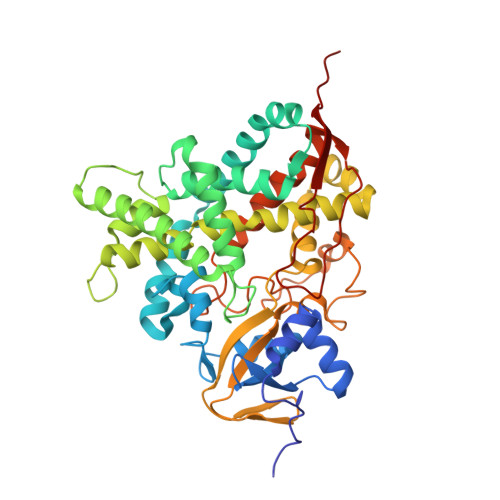Catalytic Determinants of Alkene Production by the Cytochrome P450 Peroxygenase OleTJE.
Matthews, S., Belcher, J.D., Tee, K.L., Girvan, H.M., McLean, K.J., Rigby, S.E., Levy, C.W., Leys, D., Parker, D.A., Blankley, R.T., Munro, A.W.(2017) J Biol Chem 292: 5128-5143
- PubMed: 28053093
- DOI: https://doi.org/10.1074/jbc.M116.762336
- Primary Citation of Related Structures:
5M0N, 5M0O, 5M0P - PubMed Abstract:
The Jeotgalicoccus sp. peroxygenase cytochrome P450 OleT JE (CYP152L1) is a hydrogen peroxide-driven oxidase that catalyzes oxidative decarboxylation of fatty acids, producing terminal alkenes with applications as fine chemicals and biofuels. Understanding mechanisms that favor decarboxylation over fatty acid hydroxylation in OleT JE could enable protein engineering to improve catalysis or to introduce decarboxylation activity into P450s with different substrate preferences. In this manuscript, we have focused on OleT JE active site residues Phe 79 , His 85 , and Arg 245 to interrogate their roles in substrate binding and catalytic activity. His 85 is a potential proton donor to reactive iron-oxo species during substrate decarboxylation. The H85Q mutant substitutes a glutamine found in several peroxygenases that favor fatty acid hydroxylation. H85Q OleT JE still favors alkene production, suggesting alternative protonation mechanisms. However, the mutant undergoes only minor substrate binding-induced heme iron spin state shift toward high spin by comparison with WT OleT JE , indicating the key role of His 85 in this process. Phe 79 interacts with His 85 , and Phe 79 mutants showed diminished affinity for shorter chain (C10-C16) fatty acids and weak substrate-induced high spin conversion. F79A OleT JE is least affected in substrate oxidation, whereas the F79W/Y mutants exhibit lower stability and cysteine thiolate protonation on reduction. Finally, Arg 245 is crucial for binding the substrate carboxylate, and R245E/L mutations severely compromise activity and heme content, although alkene products are formed from some substrates, including stearic acid (C18:0). The results identify crucial roles for the active site amino acid trio in determining OleT JE catalytic efficiency in alkene production and in regulating protein stability, heme iron coordination, and spin state.
Organizational Affiliation:
From the Manchester Institute of Biotechnology, School of Chemistry, University of Manchester, Manchester M1 7DN, United Kingdom.

















